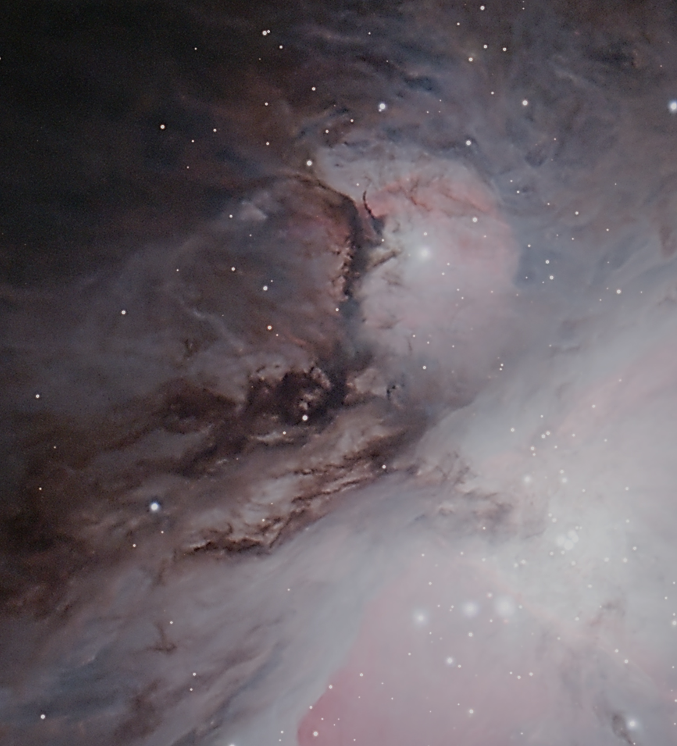A contribution by Werner Wöhrmann and Dr. Achim Tegeler, April 05, 2024
The De Mairan Nebula, which is directly adjacent to the Great Orion Nebula, is often not mentioned at all when observing the entire region around the constellation Orion. But it may be the cause of the spectacularly glowing HII regions on the Sword of Orion.
The Orion molecular cloud complex, which comprises the Great Orion Nebula M 42, the Horsehead Nebula B 33, the Flame Nebula NGC 2024 and many more objects is also home of De Mairan's Nebula, M 43 or NGC 1982.
This nebula northeast of M 42 is optically separated from the large Orion Nebula by a ribbon-like structure of gas and dust and therefore appears as a separate luminous object – an emission nebula and H II region like M 42.

The point of contact between M 43 and M 42 with the ionizing stars NU Orionis and Theta Orionis (trapezoid) (Infos on mouseover - Photo: Olaf Homeier)
In fact, however, the source that makes the gas glow in M 43 is different from that in M 42. The source of the radiation is the star NU Orionis (HD 37061). This star probably represents at least a triple system, the main component of which is classified in the spectral class B0.5 V to B1 V. The individual components of the system were discovered and characterized by spectroscopy and speckle interferometry [1] [2].
The hot star lies centrally in the molecular cloud at a distance of about 1300 light-years from Earth and has hollowed out M 43 from the inside out with its radiation.
Although the name NU Orionis tempts you to do so, one should be careful not to confuse NU Orionis with ν Orionis (Greek letter ν = n = Ny, HD 41753, often written as Nu), which is also located in Orion, but is a variable binary star that lies much further north halfway between Betelgeuse and Tejat (HD 44478) in Gemini and is only about 520 light-years from Earth.
The nebula was discovered in 1731 by Jean Jacques d'Ortous de Mairan [3] – that's where the name De Mairan's Nebula comes from. Charles Messier gave it the number 43 in his catalogue in 1769 – hence the name M 43 [4].
Like M 42 and the Horsehead Nebula, M 43 is a star-forming region that is currently being intensively explored in order to gain information about the star formation process and the formation of planetary systems.
Fukui et al. 2018 presented a theory according to which M 43 and the Orion Nebula M 42, which is 10 times as large, are two gas clouds that collided with each other about 100 million years ago (cloud-cloud collision). Due to the high speed, a shock front is said to have formed, which produced the extremely hot stars of spectral class O in M 42. Thus, the enormous stars in the trapezoid at the center of the Great Orion Nebula would have been formed in the first place by the collision with the "little brother" M 43. This theory was derived from the measured velocities of the gases within the molecular cloud complex, which makes it possible to model the collision [5].
Although M 43 is now considered to be a part of M 42 optically separated by the ribbon-shaped dust cloud, this nebula probably has a different origin and, despite its much smaller size and low stellar density, is the reason for the existence of these fascinating emission nebulae at the Sword of Orion. So it's worth taking a closer look at these two objects from time to time.
<- Back to the overview article Orion and its surroundings
Sources:
[1] Speckle Interferometry https://www.mpifr-bonn.mpg.de/251223/speckle
[3] Jean Jacques d’Ortous de Mairan https://de.wikipedia.org/wiki/Jean_Jacques_d%E2%80%99Ortous_de_Mairan
[2] Messier Catalogue https://archive.is/Rh9Y3